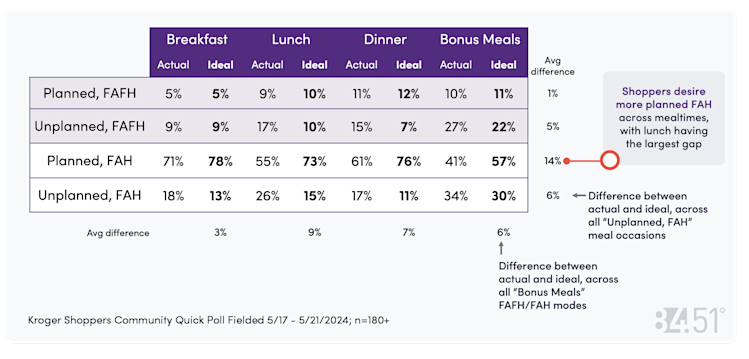
Eat at home or dine out?

Shoppers want to eat more planned meals made at home, especially lunch. The analysis, based on responses to a survey recently conducted with 180 Kroger shoppers, showed that respondents prefer to have more planned food at home (FAH) across all meal occasions, with lunch showing the largest gap between actual and ideal states.
To plan or not to plan
In today's fast-paced world, the decision to cook at home or dine out is heavily influenced by meal planning (or lack thereof). When asked to describe scenarios where the meal was not planned ahead, the respondents described three common scenarios:
Not feeling like cooking
The household is away from home
Scraping together a meal from the pantry/freezer
Oftentimes these scenarios are more favorable to food away from home (FAFH) options. But as indicated in the chart below where the respondents were asked about their actual and their ideal states for FAH and food away from home (FAFH), they would prefer to have more planned FAH. While 55% of lunches are currently planned FAH, respondents ideally want this number to be 73%. Similarly, for dinner, the ideal planned FAH is 76%, compared to the actual 61%.
Perceptions of meal planning
We also looked at shoppers’ perceptions of FAH and FAFH. Respondents categorized approaches to food as either "good" or "bad." Good approaches included disciplined consumption of healthy foods, spending only as planned, superior planning skills and productivity, and cooking for oneself or family. Conversely, bad approaches were characterized by undisciplined consumption of unhealthy foods, undisciplined spending of money, poor planning or not planning ahead, and ignorance about alternative options.
These perceptions can influence shoppers' preference for a balance between FAH and FAFH, and skew towards FAH as a "good" choice due to its association with physical health, financial savviness and cooking competence.
So, what is preventing shoppers from making more meals at home? One significant barrier is the lack of time and energy to plan, prepare and clean up after meals. In fact, “lack of time to cook” as a reason for eating out increased 5% to 20% in just one quarter, according to a quarterly survey that we conduct with about 2,000 Kroger shoppers. This suggests that shoppers are busier than ever, with less time to plan meals.
Opportunities for more FAH
CPG brands can help shoppers move towards FAH options by addressing the challenges of unplanned meals. This can be achieved by offering products that provide fast food convenience at home, such as meal starters and frozen items that can be kept on hand and easily prepared.
Messaging that highlights the benefits of meal planning and the convenience of products are also likely to resonate. By promoting solutions that ease the mental burden of planning, prepping, cooking and cleaning, brands can encourage shoppers to choose FAH options more frequently. Additionally, during busy periods like the upcoming holiday season, brands can emphasize the time-saving aspects of their products to appeal to today’s time-crunched households.
Visit our knowledge hub
See what you can learn from our latest posts.


![[DO NOT DELETE] 8451-PR header 4000x2000 shutterstock 2146084959 po](https://images.ctfassets.net/c23k8ps4z1xm/CUmZcselsJUhnLz6rQuj2/0e48394e72423bb1073bf8bb6cf75974/8451-PR_header_4000x2000_shutterstock_2146084959_po.jpg?w=328&h=232&fit=fill)